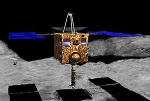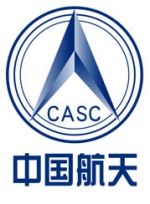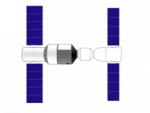Displaying items by tag: spacecraft
New Horizons (spacecraft)
New Horizons is a NASA robotic spacecraft mission currently en route to the dwarf planet Pluto. It is expected to be the first spacecraft to fly by and study Pluto and its moons, Charon, Nix, Hydra, S/2011 P 1, and S/2012 P 1, with an estimated arrival date at the Pluto–Charon system of July 14, 2015. NASA may then also attempt flybys of one or more other Kuiper belt objects, if a suitable target can be located.
New Horizons was launched on January 19, 2006, directly into an Earth-and-solar-escape trajectory with an Earth-relative velocity of about 16.26 km/s (58,536 km/h; 36,373 mph) after its last engine was shut down. Thus, the spacecraft left Earth at the greatest-ever launch speed for a man-made object. It flew by the orbit of Mars on April 7, 2006, Jupiter on February 28, 2007, the orbit of Saturn on June 8, 2008; and the orbit of Uranus on March 18, 2011. As of February 2012, its distance to Pluto is less than 10 AU (more than 20 AU from Earth).
Hayabusa
Hayabusa (はやぶさ, literally "Peregrine Falcon") was an unmanned spacecraft developed by the Japan Aerospace Exploration Agency (JAXA) to return a sample of material from a small near-Earth asteroid named 25143 Itokawa to Earth for further analysis.
Hayabusa, formerly known as MUSES-C for Mu Space Engineering Spacecraft C, was launched on 9 May 2003 and rendez-vous-ed with the asteroid Itokawa in mid-September 2005. After arriving at Itokawa, Hayabusa studied the asteroid's shape, spin, topography, colour, composition, density, and history. In November 2005, it landed on the asteroid and collected samples in the form of tiny grains of asteroidal material, which were returned to Earth aboard the spacecraft on 13 June 2010.
Jet Propulsion Laboratory (JPL)
The Jet Propulsion Laboratory (JPL) is a federally funded research and development center and NASA field center located in California, USA. JPL is managed by the nearby California Institute of Technology (Caltech) for the National Aeronautics and Space Administration (NASA).
The Laboratory's primary function is the construction and operation of robotic planetary spacecraft, though it also conducts Earth-orbit and astronomy missions. It is also responsible for operating NASA's Deep Space Network.
Among the Laboratory's major projects are the Mars Science Laboratory mission (which includes the Curiosity rover), the Cassini–Huygens mission orbiting Saturn, the Mars Exploration Rovers (Spirit and Opportunity), the Mars Reconnaissance Orbiter, the Dawn mission to the dwarf planet Ceres and asteroid Vesta, the Juno spacecraft en route to Jupiter, the Gravity Recovery and Interior Laboratory (GRAIL) mission to the Moon, the Nuclear Spectroscopic Telescope Array (NuSTAR) X-ray telescope, and the Spitzer Space Telescope.
James Webb Space Telescope (JWST)
The James Webb Space Telescope (JWST), previously known as Next Generation Space Telescope (NGST), is a planned space telescope optimized for observations in the infrared, and a scientific successor to the Hubble Space Telescope and the Spitzer Space Telescope. The main technical features are a large and very cold 6.5 meter diameter mirror, an observing position far from Earth, orbiting the Earth–Sun L2 point, and four specialized instruments. The combination of these features will give JWST unprecedented resolution and sensitivity from long-wavelength visible to the mid-infrared, enabling its two main scientific goals — studying the birth and evolution of galaxies, and the formation of stars and planets.
Organization: NASA, with significant contributions from ESA and CSA.
China Aerospace Science and Technology Corporation (CASC)
The China Aerospace Science and Technology Corporation (CASC) is the main contractor for the Chinese space program.
It is state-owned and has a number of subordinate entities which design, develop and manufacture a range of spacecraft, launch vehicles, strategic and tactical missile systems, and ground equipment. It was officially established in July 1999 as part of a Chinese government reform drive, having previously been one part of the former China Aerospace Corporation. Various incarnations of the program date back to 1956.
Tiangong 1
Tiangong-1 is China's first space laboratory module, an experimental testbed to demonstrate the rendezvous and docking capabilities needed to support a space station complex. Launched unmanned aboard a Long March 2F/G rocket on 29 September 2011, it is part of the Tiangong program, which aims to place a larger, modular station into orbit by 2020. Tiangong-1 will be deorbited in 2013, and replaced over the following decade by the larger Tiangong-2 and Tiangong-3 modules.
Tiangong-1 will be visited by a series of Shenzhou spacecraft during its two-year operational lifetime. The first of these, the unmanned Shenzhou 8, successfully docked with the module in November 2011; the manned Shenzhou 9 mission is expected to launch to Tiangong-1 in June 2012.
The Spaceship Company
Headquartered at Mojave Air and Space Port, The Spaceship Company is the aerospace production company, founded by Virgin Galactic and Scaled Composites, which will be building a fleet of commercial spaceships (SpaceShipTwos) and carrier aircraft (WhiteKnightTwos) intended to make regular, commercial, manned space travel a reality.
The company has announced plans to build three WhiteKnightTwo aircraft and five SpaceShipTwo rocket planes.
Ball Aerospace
Ball Aerospace & Technologies Corp. (commonly Ball Aerospace) is a manufacturer of spacecraft, components, and instruments for national defense, civil space and commercial space applications.
This American company is a wholly owned subsidiary of Ball Corp., with primary offices in Boulder and facilities in Broomfield and Westminster in Colorado, with smaller offices in New Mexico, Ohio, Georgia, Northern Virginia, and Maryland.
Ball Aerospace began building pointing controls for military rockets in 1956, and later won a contract to build one of NASA’s first spacecraft, the Orbiting Solar Observatory. Over the years, the company has been responsible for numerous technological and scientific projects and continues to provide aerospace technology to NASA and related industries.
Virgin Galactic
Virgin Galactic is a company within Richard Branson's Virgin Group which plans to provide sub-orbital spaceflights to space tourists, suborbital launches for space science missions and orbital launches of small satellites.
Further in the future Virgin Galactic hopes to offer orbital human spaceflights as well. Virgin Galactic's spacecraft are launched from a large aeroplane, giving the spacecraft more initial speed and altitude than if it were launched from the ground.
Ascentio Technologies SA
We are a technology company that offers an execution capacity for different projects such as engineering, software and hardware development, communications and operations. All of these features are related to high availability systems.
This capability is supported by achievements of several projects in which the company has been involved and the experience and compromise of our professional team.
Through their participation in engineering projects for the space industry and telecommunications over Internet services, Ascentio Technologies SA has been able to develop a diverse professional capability that enables it to undertake projects in areas such as electronic engineering, control, automation, instrumentation, software engineering and development, quality assurance for software and hardware products development.
What We Do
Services provided by Ascentio Technologies SA, with its Engineering, Software, Communications, Testing and IT divisions, are used in space mission ground segment, application of spatial information and now its product portfolio has been expanded into the competitive telecommunications industry of Call Centers.
The company focuses on two main areas. One of those areas includes design services, development, testing, validation, ntegration and operation of software units and hardware used in the space mission ground segment and in the applications of spatial information.
The other area includes activities that allow to carry forward operations of high availability facilities for two of the more demanding industries in present days, aero spatial and VoIP communications. The structure of Ascentio Technologies SA is designed to support each of these areas with a specific division.
All activities in Ascentio Technologies SA, both driving engineering projects as operation of high-availability systems, are organized by methodologies according to international standards used for projects.
In order to improve the quality of the service provided, Ascentio Technologies SAemploys professionals from different careers such as Telecommunications Engineering, Physics, Electronics Engineering, and Computer Sciences, all of them from recognized universities from Argentina such as UNRC (National University of Río Cuarto), UNC (National University of Córdoba), U.T.N (National Technical University), IUA (Argentine Universitary Institute). Additionally, some members of our staff are currently attending different postgraduate courses in institutions abroad.










